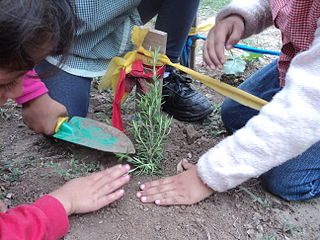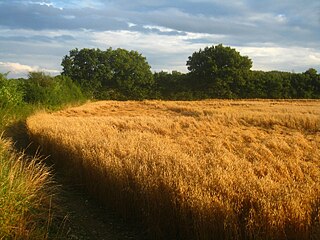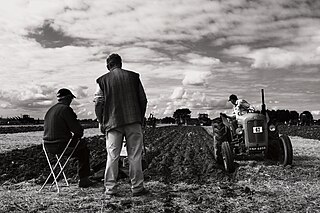 W
WAgriculture is the science, art and practice of cultivating plants and livestock. Agriculture was the key development in the rise of sedentary human civilization, whereby farming of domesticated species created food surpluses that enabled people to live in cities. The history of agriculture began thousands of years ago. After gathering wild grains beginning at least 105,000 years ago, nascent farmers began to plant them around 11,500 years ago. Pigs, sheep, and cattle were domesticated over 10,000 years ago. Plants were independently cultivated in at least 11 regions of the world. Industrial agriculture based on large-scale monoculture in the twentieth century came to dominate agricultural output, though about 2 billion people still depended on subsistence agriculture.
 W
WThis is an index of agriculture topics.
 W
WThe food industry is a complex, global network of diverse businesses that supplies most of the food consumed by the world's population. The term food industries covers a series of industrial activities directed at the production, distribution, processing, conversion, preparation, preservation, transport, certification and packaging of foodstuffs. The food industry today has become highly diversified, with manufacturing ranging from small, traditional, family-run activities that are highly labor-intensive, to large, capital-intensive and highly mechanized industrial processes. Many food industries depend almost entirely on local agriculture, produce, or fishing.
 W
WAerial application, or what is informally referred to as crop dusting, involves spraying crops with crop protection products from an agricultural aircraft. Planting certain types of seed are also included in aerial application. The specific spreading of fertilizer is also known as aerial topdressing in some countries. Many countries have severely limited aerial application of pesticides and other products because of environmental and public health hazards like spray drift; most notably, the European Union banned it outright with a few highly restricted exceptions in 2009, effectively ending the practice in all member states.
 W
WAn agrarian system is the dynamic set of economic and technological factors that affect agricultural practices. It is premised on the idea that different systems have developed depending on the natural and social conditions specific to a particular region. Political factors also have a bearing on an agrarian system due to issues such as land ownership, labor organization, and forms of cultivation.
 W
WAgricultural astrology, a type of electional astrology for gardening and for horticulture, advises scheduling the planting, cultivating and harvesting of crops based on moon phases and on astrological signs. Agricultural astrology is often referred to as "planting by the signs" because of its reliance on astrological signs for planting, cultivating and harvesting.
 W
WAn agricultural road or farm track is a service road that serves predominantly agricultural or forestry purposes and has only local significance. Agricultural roads are typically unpaved dirt roads or covered with gravel, but in some cases asphalt roads are agricultural roads.
 W
WFutureFeed is a seaweed-based feed ingredient for livestock that is currently being developed by a dedicated team from Australia's Commonwealth Scientific and Industrial Research Organisation (CSIRO). The primary component of FutureFeed is dried Asparagopsis, a genus of red algae, which has been shown to reduce the methane (CH4) emissions of ruminant livestock by up to 99%. It is added to fodder at feedlots in dosages of 1-2% dietary intake to achieve this result. FutureFeed is currently being developed in collaboration with James Cook University (JCU) and Meat and Livestock Australia (MLA), with the primary goal of scaling for mainstream commercial use.
 W
WAgrivoltaics or agrophotovoltaics is co-developing the same area of land for both solar photovoltaic power as well as for agriculture. The coexistence of solar panels and crops implies a sharing of light between these two types of production. This technique was originally conceived by Adolf Goetzberger and Armin Zastrow in 1981. The word 'agrivoltaic' was coined in 2011.
 W
WAgrometeorology is the study of weather and use of weather and climate information to enhance or expand agricultural crops and/or to increase crop production. Agrometeorology mainly involves the interaction of meteorological and hydrological factors, on one hand and agriculture, which encompasses horticulture, animal husbandry, and forestry.
 W
WA beneficial weed is an invasive plant not generally considered domesticated that has some companion plant effect, is edible, contributes to soil health, adds ornamental value, or is otherwise beneficial. Beneficial weeds include many wildflowers, as well as other weeds that are commonly removed or poisoned.
 W
WBiosaline agriculture is the production and growth of plants in saline rich groundwater and/or soil. In water scarce locations, salinity poses a serious threat to agriculture due to its toxicity to most plants. Abiotic stressors such as salinity, extreme temperatures, and drought make plant growth difficult in many climate regions. Integration of biosaline solutions is becoming necessary in arid and semiarid climates where freshwater abundance is low and seawater is ample. Salt-tolerant plants that flourish in high-salinity conditions are called halophytes. Halophyte implementation has the potential to restore salt-rich environments, provide for global food demands, produce medicine and biofuels, and conserve fresh water.
 W
WCare farming is the use of farming practices for the stated purpose of providing or promoting healing, mental health, social, or educational care services. Convicts may also be required to spend time at care farms. Care farms may provide supervised, structured programs of farming-related activities, including animal husbandry, crop and vegetable production and woodland management. Some farms attempt to alleviate the effects of the medically-unrecognized condition nature deficit disorder.
 W
WA controlled atmosphere is an agricultural storage method in which the concentrations of oxygen, carbon dioxide and nitrogen, as well as the temperature and humidity of a storage room are regulated. Both dry commodities and fresh fruit and vegetables can be stored in controlled atmospheres.
 W
WDeep plowing is a plowing to a depth greater than 50 cm (20 in) as compared to ordinary plowing which rarely exceeds 20 cm (8 in). The purpose of deep plowing is to modify the soil water retention characteristics over the long term. In one long-term test, lasting 35 years, the mean annual grain yield was 2,800 lbs per acre with deep plowing, which was 10% greater than the 2,550 lbs per acre yield in unplowed plots.
 W
WDigeponics (pronounced die-jeh-ponics, as in digestion) is a method of agriculture which integrates the products of anaerobic digestion, including CO2 and digestate, with greenhouse cultivation of vegetables.
 W
WThe Food Information and Control Agency is the Spanish Department of Agriculture, Fisheries and Food agency responsible for managing the information and control systems of the olericulture, dairy and other markets that the Ministry determines; the control of compliance with the Food Chain Improvement Act of 2013 and the official control of Protected Designations of Origin and Geographical Indications whose territorial scope extends to more than one autonomous community, before the commercialization.
 W
WHeliciculture, commonly known as snail farming, is the process of raising edible land snails, primarily for human consumption or cosmetic use. The meat and snail eggs can be consumed as escargot and as a type of caviar respectively. Mucus, commonly known as snail slime, has medical properties and is used in cosmetics.
 W
WAgricultural hydrology is the study of water balance components intervening in agricultural water management, especially in irrigation and drainage.
 W
WLand grabbing is the contentious issue of large-scale land acquisitions: the buying or leasing of large pieces of land by domestic and transnational companies, governments, and individuals.
 W
WIn agriculture, a living mulch is a cover crop interplanted or undersown with a main crop, and intended to serve the purposes of a mulch, such as weed suppression and regulation of soil temperature. Living mulches grow for a long time with the main crops, whereas cover crops are incorporated into the soil or killed with herbicides.
 W
WLodging is the bending over of the stems near ground level of grain crops, which makes them very difficult to harvest, and can dramatically reduce yield. Lodging in cereals is often a result of the combined effects of inadequate standing power of the crop, and conditions such as rain, wind, hail, topography, soil, previous crop, and others.
 W
WNeglected and underused crops are domesticated plant species that have been used for centuries or more for their food, fibre, fodder, oil or medicinal properties, but have been reduced in importance over time. A wide range of terminology is used to describe these crops, including: orphan, abandoned, lost, underutilized, local, minor, traditional, alternative, niche, or underdeveloped; in recent fashion, these are often referred to as forgotten or smart food. Reductions in use may pertain to, among other things: supply or consumption constraints, poor shelf life, unrecognized nutritional value, poor consumer awareness, and reputational problems. Some crops have been so neglected that genetic erosion of their genepools has become so severe that they are often regarded as lost crops.
 W
WNutrient film technique (NFT) is a hydroponic technique where in a very shallow stream of water containing all the dissolved nutrients required for plant growth is re-circulated past the bare roots of plants in a watertight gully, also known as channels.
 W
WPlastic mulch is a product used in plasticulture in a similar fashion to mulch, to suppress weeds and conserve water in crop production and landscaping. Certain plastic mulches also act as a barrier to keep methyl bromide, both a powerful fumigant and ozone depleter, in the soil. Crops grow through slits or holes in thin plastic sheeting. Plastic mulch is often used in conjunction with drip irrigation. Some research has been done using different colors of mulch to affect crop growth. This method is predominant in large-scale vegetable growing, with millions of acres cultivated under plastic mulch worldwide each year.
 W
WThe term plasticulture refers to the practice of using plastic materials in agricultural applications.The plastic materials themselves are often and broadly referred to as "ag plastics". Plasticulture ag plastics include soil fumigation film, irrigation drip tape/tubing, plastic plant packaging cord, nursery pots and bales, but the term is most often used to describe all kinds of plastic plant/soil coverings. Such coverings range from plastic mulch film, row coverings, high and low tunnels (polytunnels), to plastic greenhouses.
 W
WA ploughing match is a contest between people who each plough part of a field. Nowadays there are usually classes for horse-drawn ploughs and for tractor ploughing. Points are awarded for straightness and neatness of the resulting furrows.
 W
WPollination management is the label for horticultural practices that accomplish or enhance pollination of a crop, to improve yield or quality, by understanding of the particular crop's pollination needs, and by knowledgeable management of pollenizers, pollinators, and pollination conditions.
 W
WReuse of excreta refers to the safe, beneficial use of treated animal or human excreta after applying suitable treatment steps and risk management approaches that are customized for the intended reuse application. Beneficial uses of the treated excreta may focus on using the plant-available nutrients that are contained in the treated excreta. They may also make use of the organic matter and energy contained in the excreta. To a lesser extent, reuse of the excreta's water content might also take place, although this is better known as water reclamation from municipal wastewater. The intended reuse applications for the nutrient content may include: soil conditioner or fertilizer in agriculture or horticultural activities. Other reuse applications, which focus more on the organic matter content of the excreta, include use as a fuel source or as an energy source in the form of biogas.
 W
WA root cellar or earth cellar is a structure, usually underground or partially underground, used for storage of vegetables, fruits, nuts, or other foods. Its name reflects the traditional focus on root crops stored in an underground cellar, which is still often true. A wide variety of foods can be stored for weeks to months, depending on the crop and conditions. The structure may not always be underground.
 W
WA seedbed or seedling bed is the local soil environment in which seeds are planted. Often it comprises not only the soil but also a specially prepared cold frame, hotbed or raised bed used to grow the seedlings in a controlled environment into larger young plants before transplanting them into a garden or field. A seedling bed is used to increase the number of seeds that germinate.
 W
WStubble burning is the practice of intentionally setting fire to the straw stubble that remains after grains, such as rice and wheat, have been harvested. The technique was widespread until the 1990s, when governments increasingly restricted its use.
 W
WThreshing is the process of loosening the edible part of grain from the straw to which it is attached. It is the step in grain preparation after reaping. Threshing does not remove the bran from the grain.
 W
WTillage erosion is a form of soil erosion occurring in cultivated fields due to the movement of soil by tillage. There is growing evidence that tillage erosion is a major soil erosion process in agricultural lands, surpassing water and wind erosion in many fields all around the world, especially on sloping and hilly lands A signature spatial pattern of soil erosion shown in many water erosion handbooks and pamphlets, the eroded hilltops, is actually caused by tillage erosion as water erosion mainly causes soil losses in the midslope and lowerslope segments of a slope, not the hilltops. Tillage erosion results in soil degradation, which can lead to significant reduction in crop yield and, therefore, economic losses for the farm.
 W
WA windbreak (shelterbelt) is a planting usually made up of one or more rows of trees or shrubs planted in such a manner as to provide shelter from the wind and to protect soil from erosion. They are commonly planted in hedgerows around the edges of fields on farms. If designed properly, windbreaks around a home can reduce the cost of heating and cooling and save energy. Windbreaks are also planted to help keep snow from drifting onto roadways or yards. Farmers sometimes use windbreaks to keep snow drifts on farm land that will provide water when the snow melts in the spring. Other benefits include contributing to a microclimate around crops, providing habitat for wildlife, and, in some regions, providing wood if the trees are harvested.